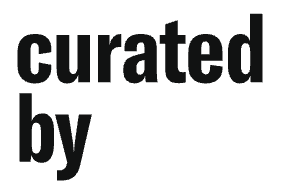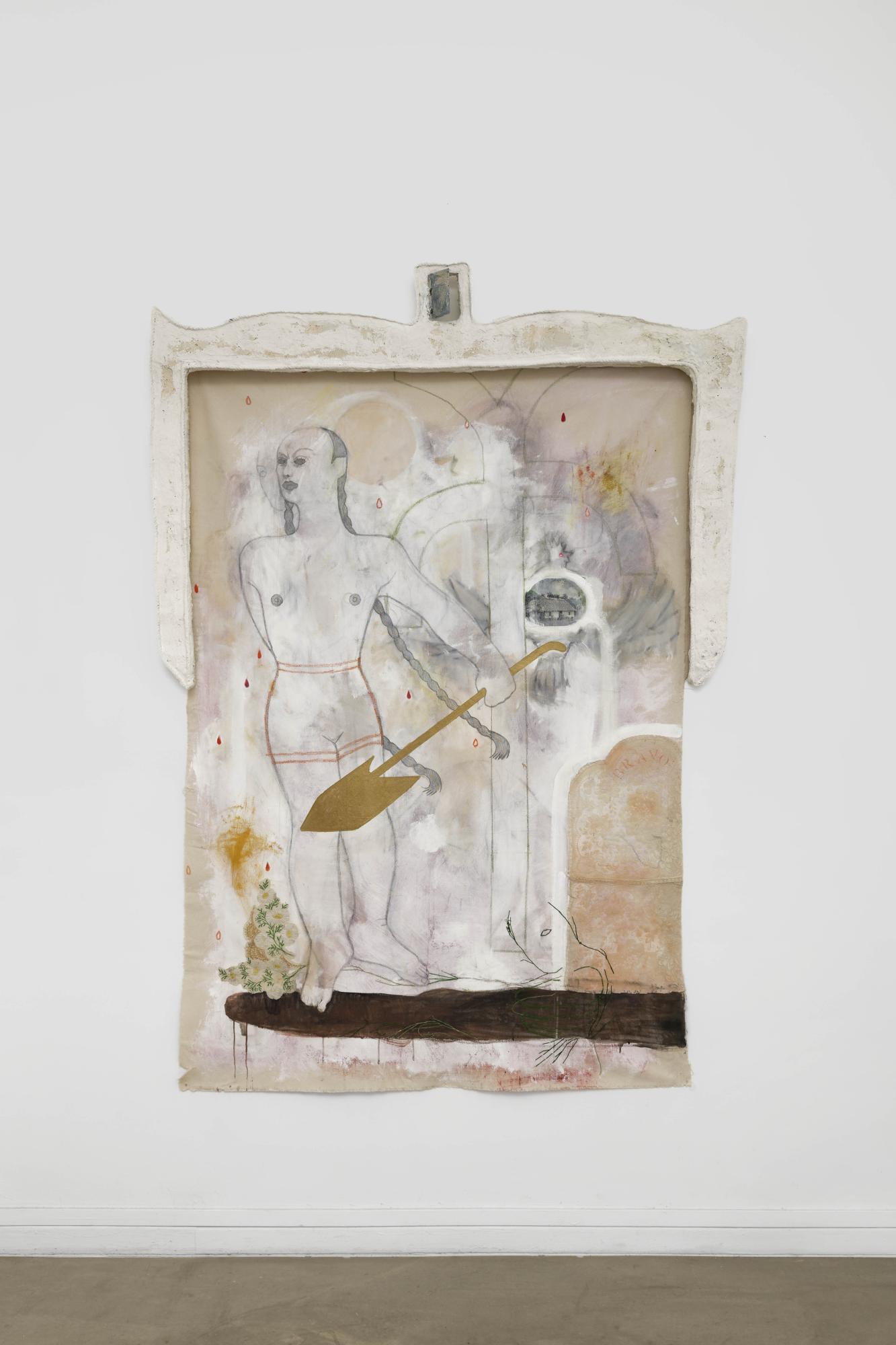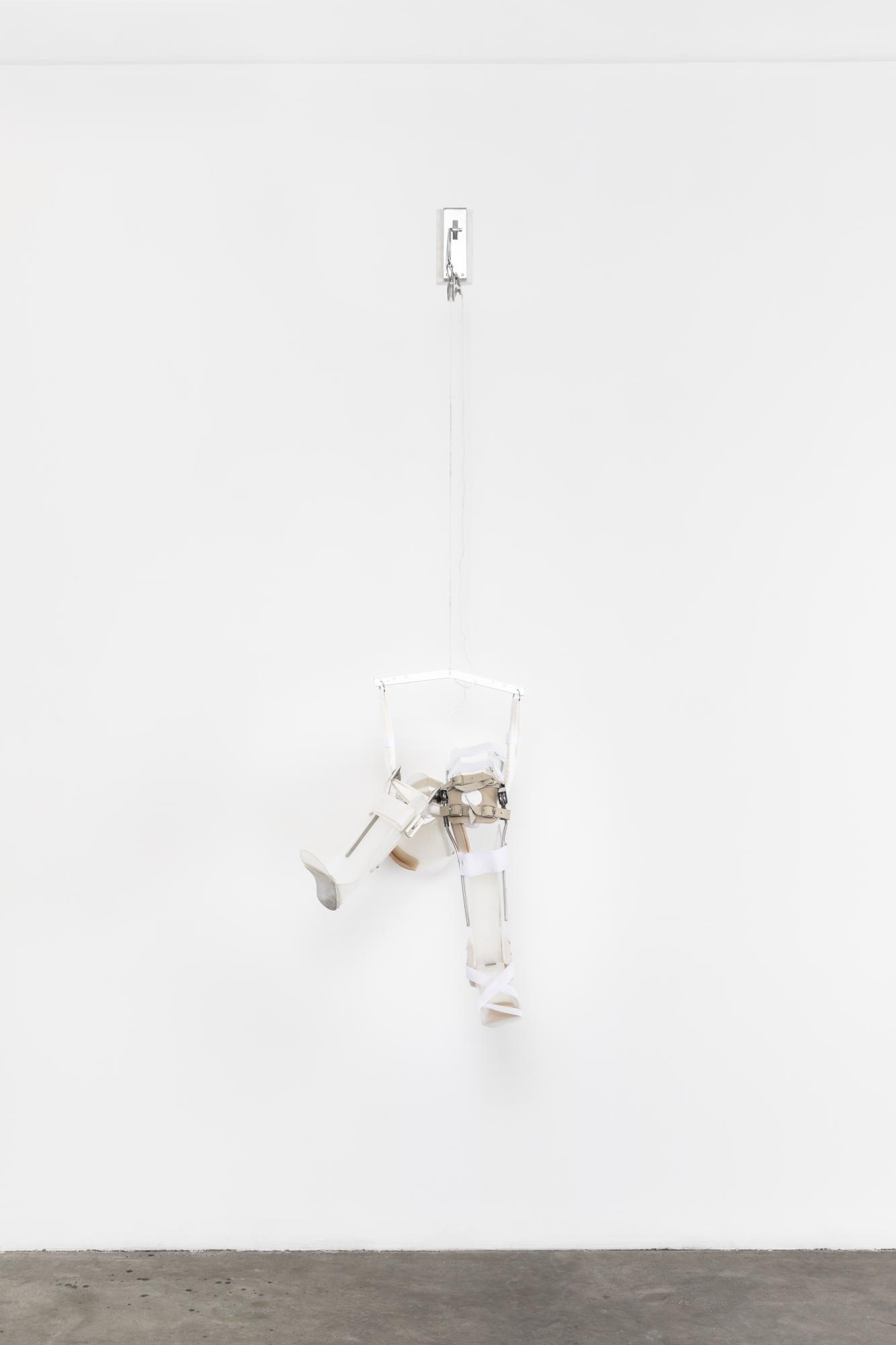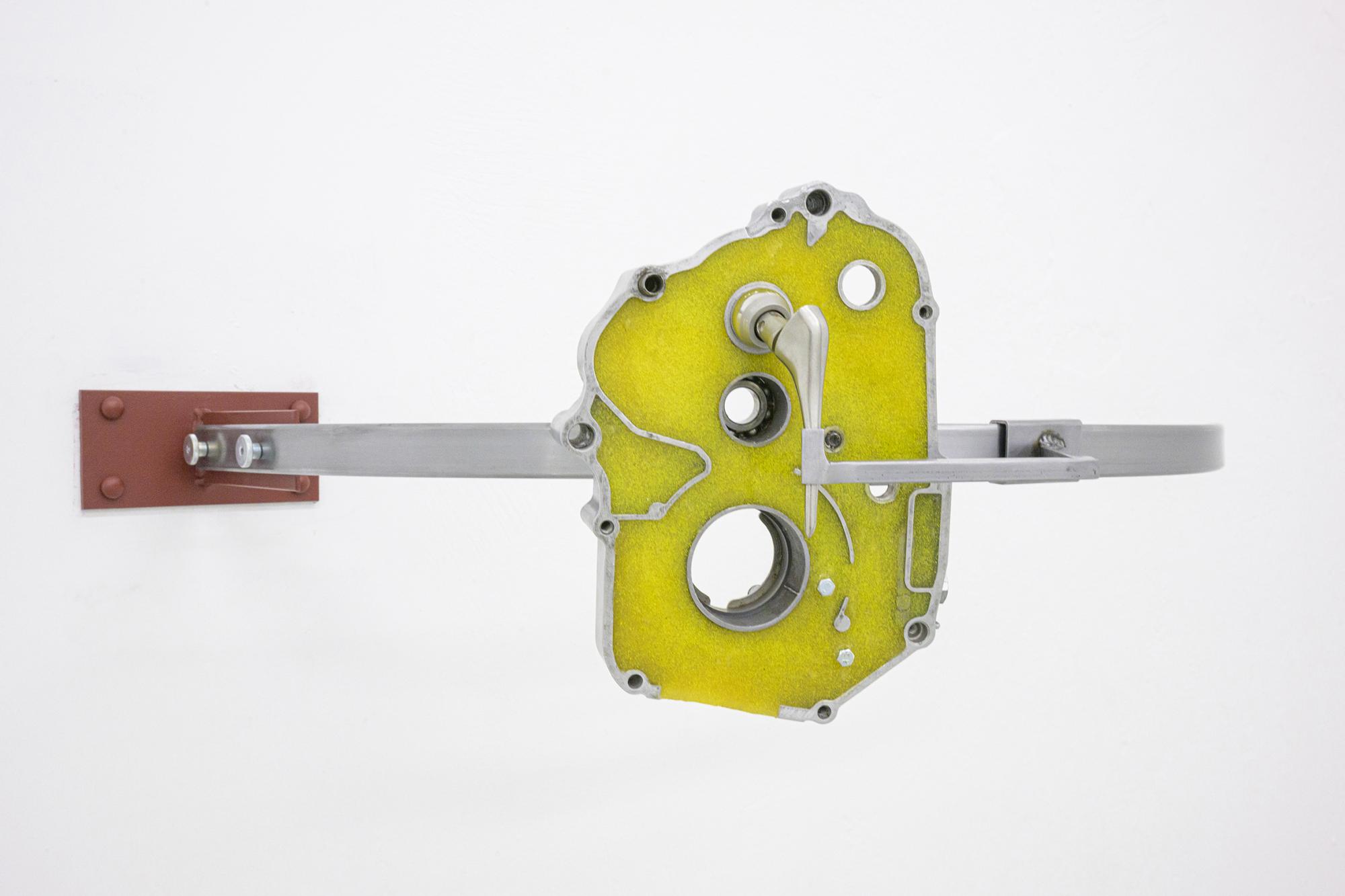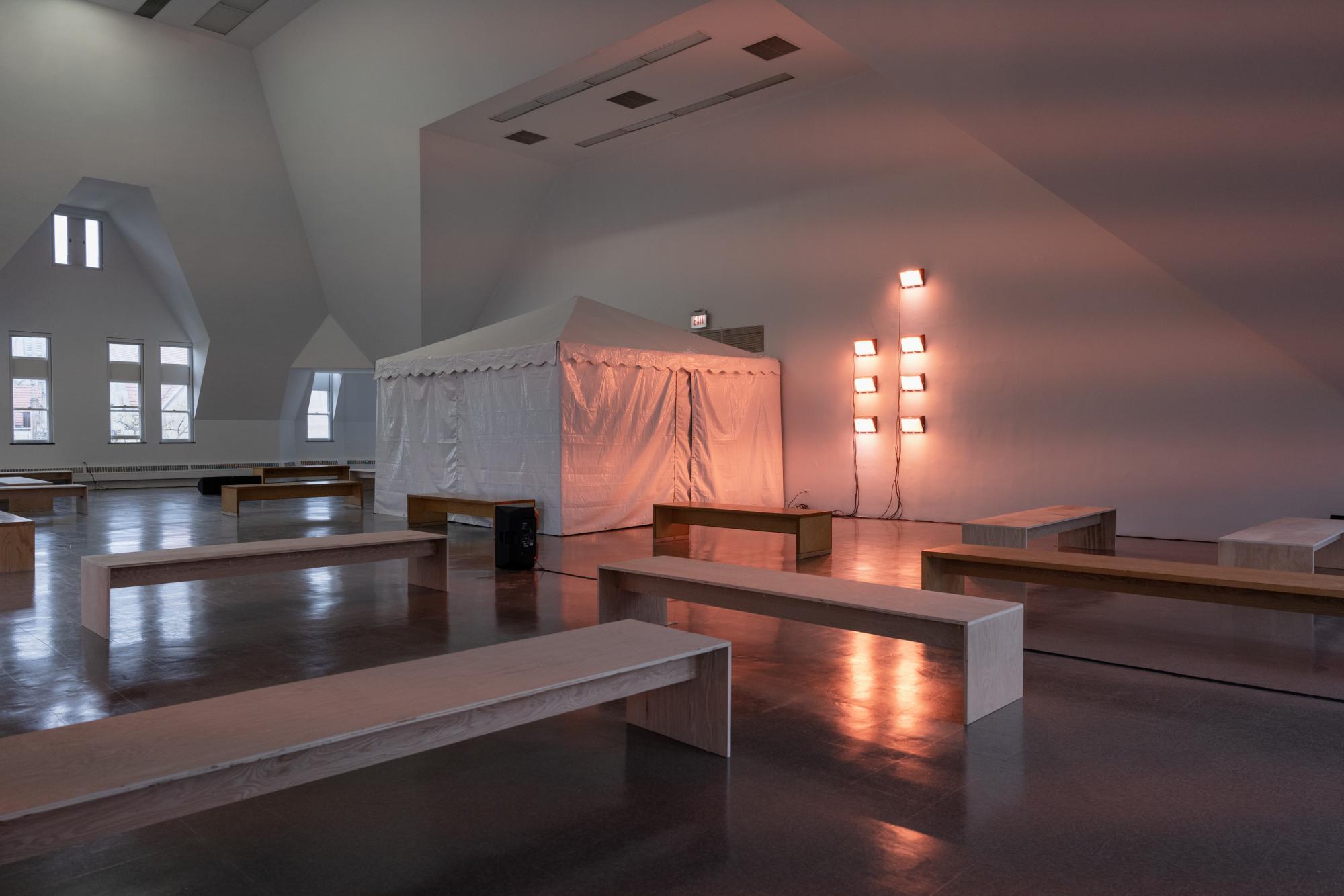GIANNI MANHATTAN curated by Madeleine Planeix-Crocker
„SPINE“

www.giannimanhattan.com
Curator(s):

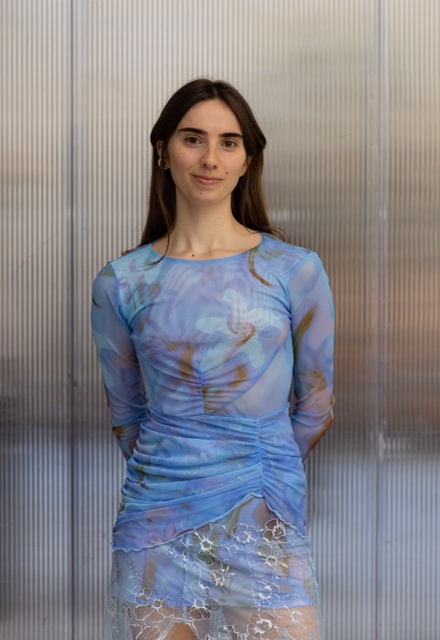
Artist(s):
-
Amy Bravo MoreAmy Bravo is a New York based artist of Cuban Italian origin. Her works combine symbolism—stylized palm trees, roosters, horses and waxed mustaches—artifacts from Latin American religious and popular culture and family stories, to create her own intimate and imaginative vision of the island of Cuba, a mixture of the familiar and the unknown, of beauty and bewilderment. She has an unconventional approach to painting, preferring irregular shaped canvasses to the classic stretcher forms, and mixing black and colored pencil drawings with various other disciplines such as painting and collage using materials such as string, leather, dried leaves and lace amongst other diverse objects drawn from her personal and family history. This very particular combination of techniques, where pride of place is given to DIY and popular culture, fits in perfectly with the intentions of her work: to bring together complex identities, to rebuild a family lineage interrupted by exile, to reimagine her ancestral home and to sketch the outlines of a mythical world. Thus, her works have given birth to a rural community populated by Amazons, women wrestlers and cowgirls; proud and liberated women at the crossroads of the three communities asserted by the artist: Women, Brown and Latinx. Born in 1997 in New Jersey, Amy Bravo lives and works in Brooklyn, New York. After graduating from the Pratt Institute, she obtained a MFA at Hunter College in New York in 2022. Amongst recent exhibitions, she had a solo show at Nada Miami and a duo show at Swivel Gallery in New York in 2022. In 2022, she also benefitted from a residency at the Fountainhead Residency in Miami.
-
Carina Emery MoreCarina Emery (b. 1991, Switzerland) lives and works in Paris and Malmö. She holds an MFA from Malmö Art Academy, graduated from École des Beaux-Arts de Paris, and studied Critical Theory at the Zurich University of the Arts. She was a finalist for the Swiss Art Awards in 2022 and 2024. Her previous residencies include "À L'Œuvre!" at Lafayette Anticipations in Paris (2022), Kultur-Kontakt Austria in Vienna (2018) and Villa Belleville in Paris (2021). In 2025, she will participate in the Open Studio Program at Fonderia Battaglia in Milan. Since 2023, Emery is an external tutor at Malmö Art Academy. Her work has been shown at Kunsthalle Bern; Le Houloc, Paris; Galerie für Gegenwartskunst, Freiburg i.Br.; Den Frie, Copenhagen; Espace Voltaire, Paris; Giulietta, Basel; Arcway Nightlands Connector, Copenhagen; Canopy, Malmö; Palais des Beaux-Arts, Paris; VinVin Gallery, Vienna; Kunsthaus Langenthal; Centre d'art Pasquart Biel/Bienne; Kulturdrogerie, Vienna.
-
Alison Flora MoreFor nearly ten years, Alison Flora (born in 1992) has been using drawing and painting, as well as sculpture, music, and video, to unearth the dark side of the world and open portals to another reality, as dark as it is redemptive. Her works on paper, painted with her own blood are the most explicit embodiment of this visceral connection with the limbo of the soul and the unsolvable enigmas of the subconscious, which she also explores through music, sculpture, and her practice as a VJ (video jockey). Influenced by regional folklore and the occult sciences, by medieval architecture and Gothic literature, but also by an underground culture—metal, industrial music, raves—her work reflects the anguish and hopes, the dreams and nightmares of a generation lost in the turmoil of its time, from which it seeks to escape. The French artist has notably exhibited at the Salon de Montrouge and Les Abattoirs in Toulouse (2022), at MO.CO. in Montpellier, and at the Pavillon Southway in Marseille (2023). Since then, her pieces have joined the collections of MAC VAL and FRAC Occitanie. She will present her first solo show at DS Galerie in the fall of 2024. It was through drawing that Alison Flora took her first steps in creation from an early age. Following in the footsteps of her father, an avid draftsman, the young Frenchwoman quickly developed a rich graphic culture, from the absurd illustrations of Roland Topor to those of the Crumb family, whose dark humor would later influence her own work, and the cult animated feature film Fantastic Planet (1973) by René Laloux. This opened the doors to a fantastic parallel world for her, where drawing became both an entry point and a true "refuge." During her studies at the École Supérieure d'Art et de Design des Pyrénées in Tarbes (2012-2017), Alison Flora laid the groundwork for her pictorial universe. Her early drawings, sketched in pencil or India ink, featured a gallery of rather morbid characters: disfigured bodies, disheveled women… Inspired by gothic literature—Stoker, Sheridan Le Fanu—heroic fantasy—Tolkien—and metal and industrial music—Cosey Fanni Tutti, Genesis P-Orridge, Throbbing Gristle, COUM TRANSMISSIONS, and Coil—the artist projected the torments of the millennial generation, lost in an anxiety-ridden era plagued by great violence, onto these figures. The cathartic dimension of her pictorial practice reached its peak in 2019 when Alison Flora realized the idea that would become the cornerstone of her work: painting with her own blood. An act she describes as "transcendent," which she developed with medical precision, ritualistically collecting her blood in tubes designed for this purpose before using it as her primary material. From these layers of blood, the artist creates washes on paper in shades of purples and burgundies that dry to a brown hue, bathing her paintings in a melancholic aura reminiscent of sepia photographs.
-
Valentin Noujaïm MoreValentin Noujaïm (b. 1991, French-Lebanese) graduated from the Screenwriting Department of La Fémis in Paris and was a guest student at the Städelschule in Frankfurt am Main. Noujaïm's work challenges dominant narratives in society, shedding light on the lives of individuals and communities historically marginalized by systemic discrimination. The fantasized worlds he creates through his films also underline his commitment to explore different formats: 16mm film, archives, digital footage, and special effects. Noujaïm will present his first institutional solo show in 2025. His films have been selected in numerous festivals, including CPH:DOX, Visions du Réel, IFFR, Villa Médicis Film Festival, DocLisboa, BAFICI, DokuFest, BlackStar Film Festival et Internationale Kurzfilmtage Winterthur. His work has also been presented in several group exhibitions: Nîmes Triennale (2024), Museo Madre (2024), Magasins Généraux (2023), CNAC Magasin (2022), Salon de Montrouge (2022), Air de Paris Gallery (2022), Exo Exo Gallery (2022), Saatchi Gallery (2021), among others. His works are part of the collections of the CNAP, FRAC Bretagne and Lafayette Anticipations.
-
Berenice Olmedo MoreBerenice Olmedo's works have been exhibited at the Kunsthalle Basel; the ICA Boston, Boston; the Boros Collection, Berlin; the Dortmunder Kunstverein; the TEA Tenerife Espacio de las Artes, Tenerife; the Eres Foundation, Munich; the Museum of Contemporary Art of Monterrey; the Bemis Center for Contemporary Arts; the Krannert Art Museum, Chicago; the Museum für moderne Kunst (MMK), Frankfurt; the Simian, Copenhagen; the Museo Tamayo, Mexico City; the Haus Mödrath - Räume für Kunst, Kerpen and the Museo Universitario de Ciencias y Arte (MUCA), Mexico City; CAPC Musée d'art Contemporain de Bordeaux.
Exhibition text
More
It’s time to let go / of this posture, this torque
Maggie Nelson, “Summer Song (or, The Rose)”
After looking into scabs as the site of expulsion of deep-seated irritation, we now indulge the itch and scratch at the surface[1]. Dogged in our digging, from muscle to tendon, we reach the bone. Our journey could end here. Instead, wemeet those who continue to scratch, to scrape, to pick — doing so because there’s a complaint to be made, a quarrel to be had, a story to be told. Touching the core, arriving at the spine : this locus of interest focuses our attention to the labor of the so-called “nitpickers”. Should we lend an ear to their work, we might just catch the “crack” and “snap” of the calcified structures at which they take aim.
Here, we encounter five artists who, in a sense, take on the breaking of these worlds, erected and buttressed specifically for those with proverbial “backbone”. Each in their own way, these artists interrogate the politics that manage and inform physical architectures, as well as social choreographies that will us to “stand straight”, “keep it together”, and “soldier on”. This timely interruption of the reproduction of standard and status begs the question : what happens, indeed, when we “let go / of this posture” ?
The works gathered for Spine could therefore be approached as variations that offer breath and momentum to a movement aimed at “shift[ing] the perspective of life-world normativity into alternative builds”[2].
For instance, Berenice Olmedo researches the designated support structures meant to correct bodies deemed “abnormal”. Following a thorough examination of the technical and artificial apparatus that (re)condition movement, the artist then isolates these devices from the bodies to which they are generally attached. Exposed, the orthoses, such as Claire, appear as fragmented and fragile structures. Berenice Olmedo therefore probes : are these really the tools on which we can rely to hold us together ?
Though apparently rigid in their materiality, Carina Emery’s Stretch Receptors break the fourth wall. Arched and extending into space, they desperately seek contact. The sculptures are injected with a chartreuse silicone, reminiscent of the the jelly-filled sense organs found in cartilaginous fish, capable of recording relationships between signals and movements. Paired Clickers I refers to the more subtle articulations found in specific points of contact, such as joints, kept lubrified so as to preclude stiffness.
Armed and winged, Amy Bravo’s protagonists rise at the intersection of her Italian-Cuban cultural heritage and personal narrative, revisited. Carving out a lineage once buried by exile and ancestral conflict, while harnessing artifacts gifted by loved ones, the artist re-builds mythical moments through meshed media. Viewed as a series, these scenes carry the story of (dis)inheritance and transformation, heralded by the ghostlike traces from which the figures have seemed to emerge.
Drawing her own blood for paint, Alison Flora performs a sort of “infrastructural improv”[3] with spine-chilling effects. By unexpectedly tapping into her very own ressources (in this case, blood cells produced partially in the vertebrae), the artist’s reflexive process serves as an antidote to solitude : bereft, she is not. Indeed, the reverberating feedback loop put into practice by Alison Flora is mirrored and expanded by the piece Passage en écho : it is precisely through echolocation[4] that multiple sonic, not static, bodies are unearthed — blood ties.
“In the gut of the world”, to borrow from Alison Flora’s title, is also where Valentin Noujaïm’s protagonist seems to find herself : in this particular instance, encased in a cold skeleton of glass and steel. To Exist Under Permanent Suspicion portrays an office worker — played by Kayije Kagame — caught in a skyscraper of the Parisian central business district, La Défense. In a frenzy of loneliness, acute fatigue, and insatiable appetite, Claire fever-dreams her escape from the edifice’s core, thereby metabolizing the meaning of “burn out”.
As these five artists seize structures, making them quake, crack, and crumble, the breaking point can also feel particularly isolating.
You fracture more than a bone when you fracture a bone: you also experience a break from something; it is no longer as it was before; you are no longer as you were.
Sara Ahmed, Living a Feminist Life
Yet, staying with the assembled variations, we may understand these snaps as pivots, movements and methods that bear release, always already into each other — in other words, I’ve got your back —
I find my way by following your spine
June Jordan, “Poem for Nana”
Coda :
As is often the case in my curatorial practice, I imagine exhibitions as research opportunities. Once guided by an initial line of inquiry, I seek out, fall upon, and ricochet onto voices that shed precious light on the study. Some of these voices manifest themselves through the works shared in the show ; others accompany the articulation of texts. My words are bound in gratitude to these encounters for which I have provided complete bibliographical references with the hopes that you may dig your way through them, too —
Sara Ahmed, Living a Feminist Life, Duke University Press, 2017.
Lauren Berlant, On the Inconvenience of Other People, Duke University Press, 2022.
June Jordan, “Poem for Nana” in Directed by Desire, Copper Canyon Press, 2007.
Maggie Nelson, “Summer Song (or, The Rose)” in Something Bright, Then Holes, Zed Books, 2019.
[1] Scabs is a group show I curated in 2023 at Mécènes du Sud, Montpellier, featuring works by CAConrad, Ève Gabriel Chabanon, Mimosa Echard, HaYoung, Ndayé Kouagou, Tarek Lakhrissi, and Tai Shani. Spine represents the second chapter of a trilogy of exhibitions examining the performativity of bodily operations.
[2] Lauren Berlant, On the Inconvenience of Other People, Duke University Press, 2022, 12.
[3] Term offered up by Lauren Berlant in On the Inconvenience of Other People, 98.
[4] Echolocation is a technique used by bats, dolphins, whales, and other animals to determine the location of objects using reflected sound, as a means of navigating through pitch darkness.

